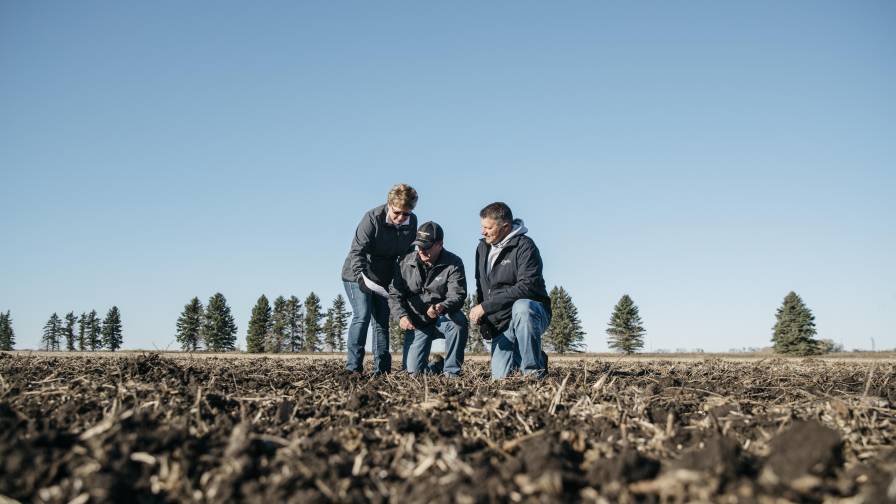How Ag Retailers Are Helping Micronutrient Manufacturers Capitalize on Strong Market Demand

Even a pandemic hasn’t slowed demand for micronutrients in 2021 as retailers remain critical in launching new products. Photo credit: The Mosaic Company
Despite what might be happening to the rest of the world, those who manufacture and sell micronutrient products have seen little disruption to their operations. And for many 2020 and 2021 have exceeded expectations.
“It’s exciting and tight; that’s how I would best describe the state of micronutrients right now,” says Chuck Anderson, VP and General Manager of The Andersons liquid specialty business.
COVID-19 certainly complicated things, but a major factor has been “grain prices, coming up so fast. There was just no time to react. There are so many different factors, so you have all these different things impacting commerce today and a super tight labor market — the tightest I’ve ever seen,” he says.
The key was ensuring supply remained available so retailers could meet customer needs.
“For the micronutrient market in 2021 we really stepped into the middle of it,” says Michael Berry, Koch’s Director of Ag Market Portfolio. “We stepped into a market with strong fundamentals — high commodity prices, decent weather conditions where growers were really wanting to push for maximum yields and so, as a result of that, we saw stronger demand later into the growing season than we really anticipated.”
“We were able to capitalize on that and recognize some sales that we didn’t really count on as part of our bet for the (Compass Minerals) acquisition, but we had supply. We never ran short, so we were able to supply our customers’ needs later in the growing season. The micronutrient market for this growing season has been strong and for us it was stronger than expected.
“We’re seeing that micronutrients are a key or one of the key pieces to help achieve those next yield goals and to help address the issues that they’re having,” Berry continues.
Jake Socherman, Vice President of Strategic Engagement at Verdesian Life Science, has seen both sides to the COVID-19 coin.
“Micronutrients continue to be an integral part of a complete nutrition program that will aid a farmer to achieve their potential yield,” he says. “So along with strong commodity prices, demand for micronutrients continues to be growing throughout agricultural markets. The 2020-21 micronutrients season presented some deeper challenges regarding supply chain and freight costs which have come in the form of product shortages, longer lead-times, and price increases.
“As we entered the 2021 season, with COVID increasing throughout the country, we weren’t sure what to expect from this season, but micronutrients have thrived during the pandemic,” Socherman continues. “Farmers want to get the most out of their crop, especially when commodity prices are strong. Our MicroSync micronutrient products have continued to exceed our expectations regarding crop performance and retailer/grower adoption.”
An overseas supply chain disruption is one issue Verdesian did not have to worry about.
“Supply chain difficulties during the pandemic have been the biggest concern, especially for those who rely on commodities out of China due to challenges around freight, availability, and increasing costs,” Socherman says. “That is where Verdesian’s MicroSync micronutrient portfolio comes in to play, as a U.S. manufacturer with domestic production and raw materials, we’ve been in a good position with our Microsync portfolio to supply when others may have difficulty. The longer-term effect of these supply chain issues will have retailers reviewing where their micronutrients are sourced.
Managing Through a Pandemic
Tom Fry, Director of Performance Products for North America at The Mosaic Co., admits the COVID-19 pandemic led to some early concerns, but they were quickly allayed by the strong market.
“Everyone was a little cautious as we’ve experienced COVID to try to understand how that might impact our businesses,” he says. “I have been pleasantly surprised at the demand for our products and our ability to meet that demand. We have been able to continue to ship additional products into the United States and Canada at rates that are well above what we did in 2019 and 2020 to support the industry.”
Challenges
That’s not to say there haven’t been some glitches along the way.
“Labor is without a doubt, a major hurdle for us in certain geographies, and then transportation,” Anderson says. “Safety stock was pretty critical due to these challenges, and we did have safety stock in certain areas, this year. I’m really excited our ability, at the Andersons to just meet the demands. The challenges have been immense with COVID. And the fact that we’ve been able to operate all of our facilities is a real tribute to the managers at each facility and the employees that stuck with it.”
Though availability wasn’t as much of an issue as some anticipated, manufacturers have had to manage through delays, and the cost of that availability has skyrocketed during the pandemic.
“We’re dealing with container freight from Asia that was $1,700 to $1,800 two years ago that is now $7,000 to the West Coast,” Anderson says. “(There is) a 40-day on average delay versus two years ago. That means the container utilization rate today for overseas shipments is at 99%, so there is no open capacity. It’s going to be a very challenging year as I see that continuing over the next 12 months and, who knows when that will let up.”
Those costs seem to be changing rapidly. According to a report from the Drewry World Container Index published mid-August, the spot rate for a 40-foot container from Shanghai to L.A. stayed near a record high, at $10,322.
“I was really impressed, quite honestly, with all our partners throughout the supply chain — the railroads have been able to stay on top, for the most part, and help us deliver the 22 and a half million tons that we produced in America, as well as around the world,” Fry says. “And despite some initial challenges they really stepped up to the plate.”
While the market for micronutrients continues to grow, there’s still huge opportunity across North America and around the world.
“We do everything we can to help growers and retailers understand the critical role that micronutrients play and how distribution across the field and proper placement on seed can help improve efficiency of their micronutrient application, help them see a greater return on investment,” Berry says. “The biggest challenge is that continual education, helping new growers see and understand.”
While education continues to be a major factor, manufacturers point to another key factor that pushed demand higher.
“Crop prices have really, created a significant amount of demand, and we have been able to match that demand for the most part,” Anderson says.
Mosaic’s Fry saw similar results.
“We had record shipments the first half of this year, so there’s extremely strong demand for fertilizer,” Fry says. “It’s a combination of excellent yields the last few years, and people utilizing these products and seeing a return on their investments, combined with stronger commodity prices that resulted in them wanting to put together the best crop nutrition plan so they can maximize their yields and profit abilities at harvest time,” Fry says.
Looking Ahead
“We see strong demand going into fall,” Fry says. “It’ll depend on exactly what the weather affects are on crops and how is it going to come off and when this fall fertilizer demand begins.
“Retailers are absolutely critical in helping farmers, as well as helping companies launch new products,” he adds. “One of the biggest challenges that both retailers and farmers face is there are so many new products coming to the market, making so many different claims.”
It’s difficult for retailers and growers to know which products to trust.
That’s where Mosaic’s long-term relationships have helped ease minds. “We’ve found that’s important with our customers and that they understand our product development process the science that goes behind it,” Fry says.
When retailers are familiar and well-voiced in the role micronutrients play in the health of crops, they play a key role in helping educate end users.
“Retailers are the touchpoint between the micronutrient producer and the grower,” Socherman says. “At Verdesian Life Sciences we provide training and education to our retail partners, to better educate them, allowing them to be the experts in the field. Our retailer partners are a key part of the relationship with the grower, providing the grower with the knowledge and confidence to include a micronutrient product in their nutritional program.”
For those with that confidence, manufacturers are continually delivering new products.
“We consider ourselves the ‘Starter Kings,’” Anderson says. The company is planning for a product launch in 2022.
PureStart liquid organic fertilizer is the first OMRI listed liquid fertilizer that may be used as a liquid starter for organic production. Produced from steamed bone meal and other natural components, PureStart provides nitrogen, phosphorus, and potassium for seedlings to encourage early, even emergence and maximum yield at harvest. “That is one we are really excited about,” he says.
Wide adoption by row crop growers is the “holy grail” for micronutrient products.
“As micronutrients continue to be adopted as a standard practice throughout the country, we see the cornbelt as a continued opportunity for growth and expanded usage,” Socherman says. “There are still many growers who don’t utilize a complete nutritional program, which includes micronutrients. In order to achieve the yield potential of today’s hybrids, micronutrients are a key part of that equation to drive to that yield goal.”
While that hope has yet to be realized, Socherman sees the start of that dream — with a caveat.
“We are seeing growth across the board in the agricultural space: Broad acre, specialty ag, turf and ornamental, and lawn and garden sector,” he says. “While all segments have had strong demand, one of the biggest challenges has been and will likely continue to be the upward pricing pressure, which has been driven by freight, supply constraints, and rising labor costs. Another continuing challenge is around education; the untreated acre continues to be one of the largest market opportunities for micronutrient growth. Continuing to educate farmers about the benefits of micronutrients and the value of replacing the micronutrients removed from the soil each season.






